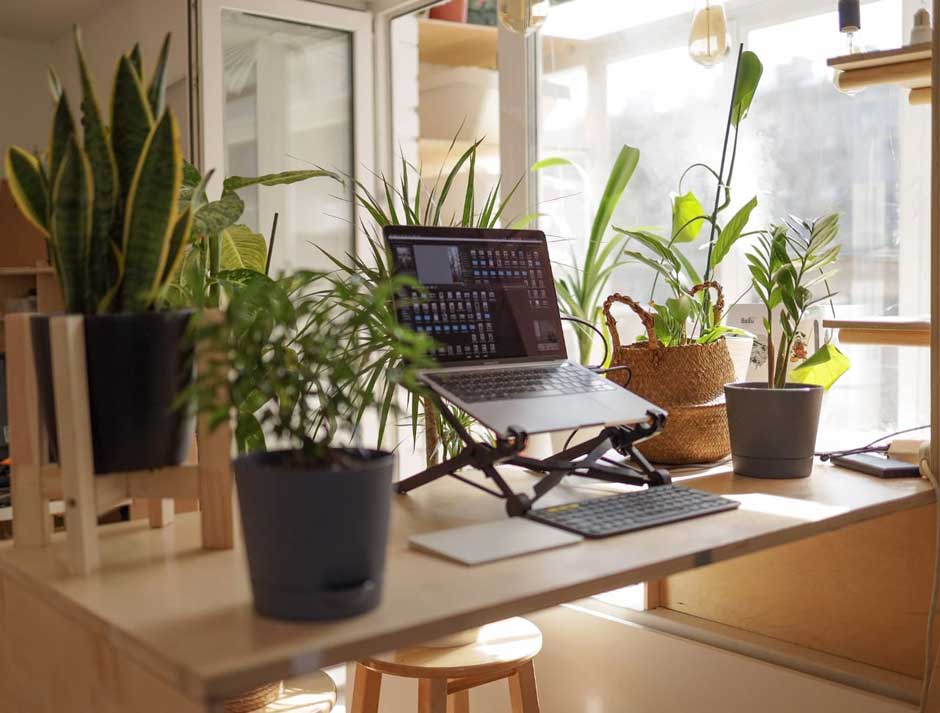Designing a Sustainable Home Office: Eco-Friendly Tips for a Green Workspace

In today’s world, Improving office sustainability is extremely important for minimising environmental impact. However, with the rise in remote working this doesn’t just fall into the hands of businesses, individuals are equally as responsible for ensuring that their home office follows as many sustainable practices as possible. This includes maximising natural light, incorporating sustainable materials, recycling appropriately and using energy efficient lighting. This article will provide tips for how to incorporate these easy solutions in your home office to create a more sustainable and eco-friendly environment.
Maximise Natural Light and Ventilation
Maximising natural light within your home office will prioritise sustainability by reducing the need for artificial lighting and minimising energy usage. To gain more natural light whilst working, position your desk in an area close to windows, to take advantage of the daylight. Not only will this reduce the need for artificial lighting in your office but it also boosts productivity by preventing headaches, eye-strain and fatigue.
Furthermore, close access to a window can help to boost ventilation within your home office. Opening a window near your desk will promote good air circulation and reduce the need for air conditioning. Air conditioning can consume a high amount of energy so natural ventilation is crucial for decreasing environmental impact.
Choose Sustainable Materials
When furnishing your home office select furniture pieces that are made from reclaimed wood, recycled or ethically sourced materials. These materials are not only eco-friendly but they are highly durable making them the ideal investment for long-lasting furniture pieces. In addition, typically no two sustainable furniture pieces are the same, which means that they will create a unique aesthetic within your office and add a touch of individuality.
Reuse, Reduce, Recycle
Reducing, reusing and recycling waste in a home office is beneficial for minimising environmental impact, improving resource efficiency and being highly cost effective.
Paper usage can be minimised by using digital documents and storing important files on cloud storage services. This will help to conserve valuable resources and contribute towards environmental protection. It is also far more convenient as it prevents the misplacement of important documents and improves productivity by providing easy access to information.
However, if you do use paper in your office then it is a good idea to reuse paper where possible. This can be done by using both sides of the paper before discarding it, for instance if you have a meeting and need to take notes ensure that you are using as much of the paper as possible before discarding it. In addition, it can be helpful to get a recycling bin for your office so if you do have to throw away items you can ensure that they will be discarded correctly.
Incorporate Energy-Efficient Lighting
Switching your traditional light bulbs to LED light bulbs can have a significant impact on the sustainability of your home office. LED light bulbs consume significantly less energy than traditional light bulbs, in some cases up to 90% less energy. Lowering energy consumption is crucial for lowering greenhouse gas emissions and conserving natural resources so it’s important to lower your energy where possible.
In addition, LED lights are not just beneficial from a sustainable standpoint but they’re also helpful for aiding productivity and concentration. LED lights are effective in imitating natural light, which helps to prevent headaches and eyestrain. They also have a longer lifespan than traditional light bulbs so coupled with their reduced energy consumption, they offer good money saving benefits.
In conclusion, designing a sustainable home office can go a long way in benefitting the environment. The transition to a more sustainable home office is a significant step towards making more responsible and environmentally conscious choices. Even the smallest of changes, from energy efficient lighting to incorporating reclaimed or sustainable furniture, can help to create an eco-friendlier environment.


